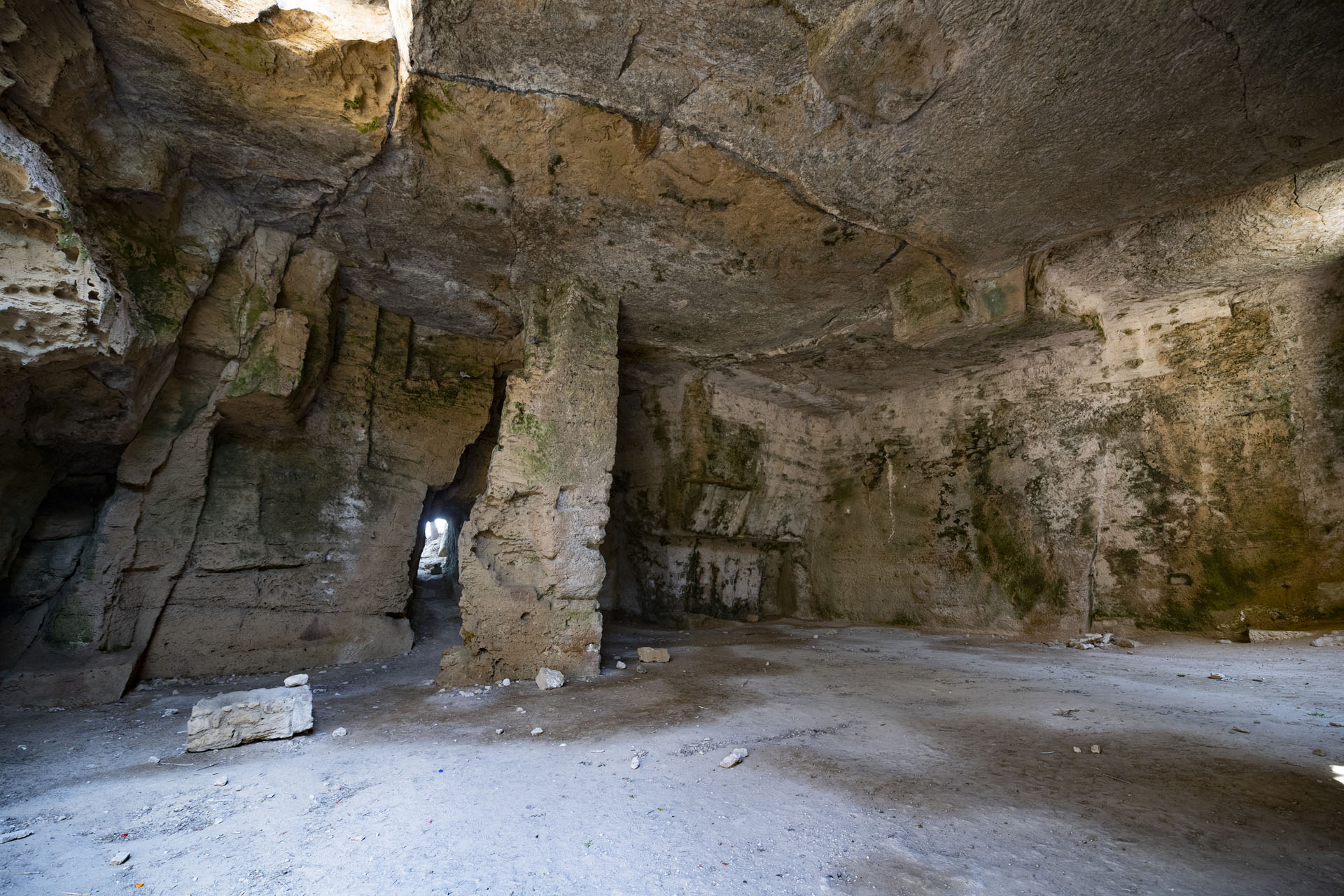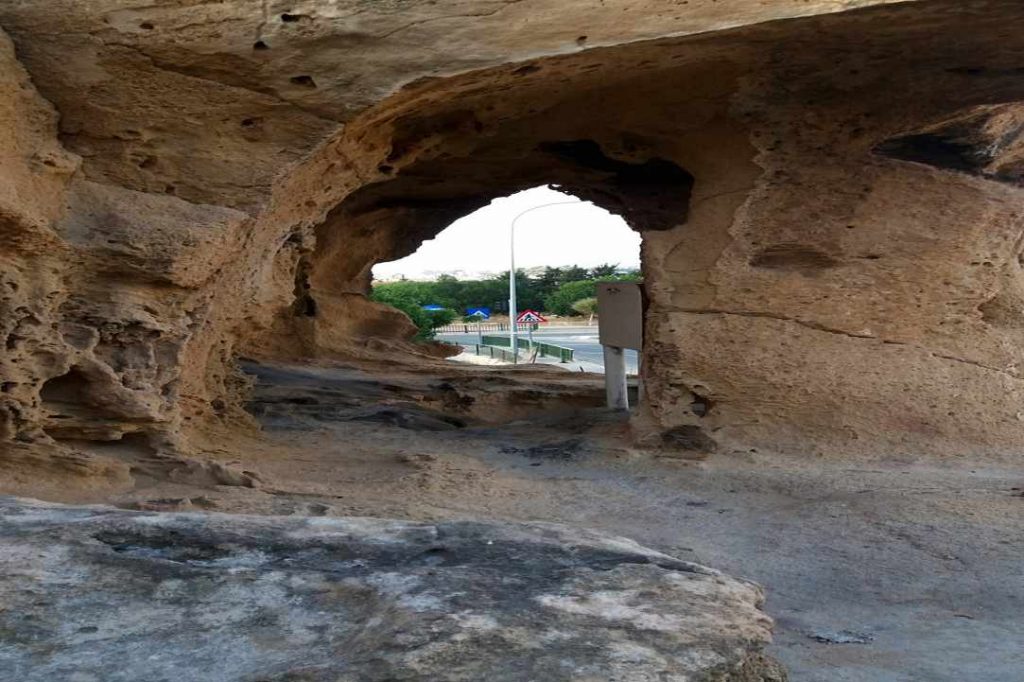Filenews 8 October 2023 - by Dora Christodoulou
The impressive and unique aerial footbridge in Cyprus that connects archaeological sites in Kato Paphos was not only one of the city's most popular enrichment projects this summer.
It also contributed to the discovery of an impressive archaeological site, which for decades now has been in the shadow of the world-renowned archaeological treasures of the city that dominate the neighbouring Archaeological Park of Kato Pafos. It is the hill of Fabrica, a system of caves within the hill that for years has been revealing its secrets to scientists and archaeologists who carry out excavations in the area.

This unique area has recently been revealed to ordinary visitors, mainly due to the operation of the impressive pedestrian bridge that dominates five meters above the ground, crossing the avenue leading to the port of the city. The almost 400-metre-long pedestrian bridge is the practical part of the huge project of unifying the archaeological sites of Kato Pafos. The pedestrian bridge in the area of the archaeological site of the hill of Fabrica, after many years of work, has been opened to the public, who can now take a walk above ground and go from one side of the archaeological sites of Kato Pafos to the other, walking over the central avenue of Apostolou Pavlou, which leads from the city center to the port and pier.

Η τεράστια πεζογέφυρα συνδέει το δυτικό με το ανατολικό τμήμα των αρχαιολογικών θησαυρών της Κάτω Πάφου, με τη μια άκρη της να βρίσκεται στο σημείο που είναι το γνωστό ξενοδοχείο Roman και την άλλη στον λόφο της Φάμπρικας. Η πεζογέφυρα διέρχεται σε μεγάλο ύψος πάνω από την λεωφόρο Αποστόλου Παύλου, δίνοντας ένα εντυπωσιακό πλάνο στους περιπατητές και επισκέπτες των αρχαιοτήτων, αφού έχουν τη δυνατότητα να απολαμβάνουν οπτικά ολόκληρη την αρχαιολογική περιοχή της Πάφου.
The enjoyment of strolling above ground and touring antiquities in the area from the air has had collateral benefits this summer, archaeologists tell "F". Thousands of visitors to the site, taking advantage of the possibility of transportation offered by the bridge, were able to discover another archaeological treasure of Pafos, which most had only heard of as a point of excavation work for many years.
The hill of Fabrica, which is called by experts the hidden archaeological gem of Pafos, occupies a central role in the great project of unification of the archaeological sites of Pafos, part of which was also the construction of the above-ground pedestrian bridge. The architect and then head of infrastructure of the Organization for the European Capital of Culture Pafos 2017, Yiannis Koutsolambros, explains that the main idea is based on the creation of a tour, a reverent archaeological walk at the same time and an urban route that maps the unification of archaeological sites with references for the visitor in both the old and modern city. The study of the architects that won the relevant competition, he says, recognizes the interruption of the smooth movement of the existing arteries, Apostolou Pavlou Avenue and Agia Kyriaki Street and strategically with the addition of the pedestrian bridge, unifies the archaeological site on multiple levels, creating the conditions for unification and enrichment of the archaeological experience, he explains.

On a historical and functional level, says Mr. Koutsolambros, the project unifies the archaeological sites on both sides of Apostolou Pavlou Avenue. It restores unity in a gentle way, with smoothness in movement that gives unhindered access to people with disabilities, but also to the general public and with this location creates a timely and selected observation platform of the archaeological site. On an ecological level, it achieves the integration of the ecosystem with the substantial transfer of flora elements to the bridge itself, functioning an integral element of the ecosystem itself. It is coated with slotted sheet metal and as a floor uses a metal grill, under which there are elements of the ecosystem, such as soil, flora, etc., he explains.
On the pedestrian bridge there are also elements of linear lighting integrated into the construction at pedestrian level and support pillars to illuminate it from below and highlight it as an entrance signal, he stresses. Its static carrier is steel. Its central beam will be made of round hollow cross section with a diameter of 600mm that has great torsional rigidity and can receive the flexural and torsional moments imposed by its curved form. Its support was again made with hollow cross-sections at variable distances from each other so that there is the possibility of avoiding antiquities.
Discovery of Hellenistic Theatre
Fabrica Hill has been the site of rescue excavations by the University of Avignon mission in collaboration with the Department of Antiquities of Cyprus for years. It is the area that gave a few years ago the great discovery of the Hellenistic Theater, the largest to date and best preserved theater of this period throughout Greece.
From the other important findings of archaeologists we now know that Fabrica Hill was a very important district of the ancient city, which included new buildings and basic infrastructure works, such as water supply facilities. In 2015, crews of the Department of Antiquities carried out works for the consolidation and conservation of the ruins of a Roman house, a fact that turned the spotlight on the area, which was already well known to scientists as an important component of Pafos' glorious past.
View to visitor
The major project of the unification of the archaeological sites of Kato Pafos, which is now in the process of completion, is considered one of the most important projects of recent decades for the city and district of Pafos, since it now gives the opportunity to further promote the rare archaeological wealth of Pafos internationally. The new project ends and points of reference in the Square of Nations, where Apostle Paul preached during his passage through Pafos.
The project of the unification of the archaeological sites in Kato Pafos serves multiple objectives, the main of which are the restoration of the functionality of the ancient landscape, the assistance of archaeological research and the promotion of its results to the visitor, the unification and enrichment of the archaeological experience and its interconnection with layers of modern history and the modern city. as well as the restoration of the natural environment.
